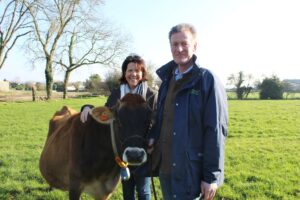Recently retired Victoria College head of history ANDY GILSON is in the process of writing a book on faming in Jersey during the Occupation, which is being sponsored by the Royal Jersey Agricultural and Horticultural Society.
In this first of two preview articles.expanded from his contribution to the spring 2015 issue of RURAL – Jersey Country Life, he discusses the impact of the Occupation on the growing of crops
A REPORT in 1945 stated that the Occupation had convulsed the economic life of the Island. The agricultural economy after 1 July 1940 remained the only economic activity left to sustain Jersey. The thriving Island tourist and the fishing industry died overnight. In simple terms the agricultural economy had to feed 41,000 islanders and the German garrison.
The export of the Royal was immediately halted. The only market was England and it was now lost. The remaining potatoes were put into clamps at St. Lawrence, St Mary and the People’s Park. They became an important food source throughout 1941. The first and second outdoor tomatoes crops were uprooted and the soil prepared for cereal crops, along with a new Island wide cropping plan.
Jersey’s agricultural economy had been based on cash crops of Jersey Royal potatoes and outdoor tomatoes exported to the early markets in the UK; in addition, all agricultural inputs were imported from there. In 1939, 67,530 tons of Jersey Royals had been exported, worth £922,254, even with the loss of three weeks shipping because of the evacuations.
A remarkable changeover in the cropping plan was immediately devised by the able head of the Department of Agriculture, Touzel Brée. A huge increase in arable crops was ordered by his department: wheat, barley, rye and oats became the main agricultural outputs, along with milk and a second main crop of potatoes. Apart from one threshing machine imported from France, the Island was lucky that a number of threshing companies were still in active operation in the summer of 1940 and by 17 November 1940 the first wheat crop was ready. The Department of Agriculture, along with another far sighted and hardworking States member, the Head of Employment, Deputy Edward Le Quesne, resurrected five old mills to make flour and 3,120 tons of wheat would now be grown annually.
In a letter of 1945 to the UK government, the area of agricultural land use changed over from ‘potatoes and tomatoes’ and increased from 909 vergées of wheat, oats, barley and rye (1939) to 12,735 vergées (1944). This accounted for 19.7% of the total land area of Jersey. The reason for the changeover in the agricultural economy was simple: “During the occupation the whole cultivation plan of the Island had of necessity to be radically altered, the survival of the population requiring that as great an area as possible of cereals and especially of wheat should be grown.’
From a letter of March 1941, titled ‘Report on Crops and Cultivated Area’ it seems that the actual area for cereal growing was in fact some 26.7% of the total land area of Jersey.
In another letter from the German authorities it was made clear to the Jersey Government and the Department of Agriculture that the 20,000 vergées of potatoes planted had to be reduced to 6,000. In addition they demanded that 17,000 vergées of wheat, barley and oats should be grown and 3,500 vergées of mangolds for stock feeding. This cropping plan generally remained in force for the years 1941 to 1944 and demonstrates quite clearly that the Nazis really ran the agricultural economy and were the ultimate power.
The far sighted instigator of the new Island-wide cropping plan was Touzel Brée, nicknamed ‘The Little Breton’ by the German 515 Field Command. Brée was trusted by his fellow farmers and set about winning them over to the idea that their responsibility was not just to themselves but to the Island population.
In effect they were now civil servants, very much in the manner that doctors became state employees in the National Health Service in 1948, and a number of farmers reacted in the same manner. When in December 1940 farmers voiced their disapproval as to their position in the new world order, Coutanche gave them a forthright explanation as to the realities of the occupation and warned them of the consequences. The German Field Command 515 told the Bailiff and Superior Council what they wanted in terms of produce and then this was cascaded down to Bree and the Department of Agriculture, to the Jersey Framers Union and the Royal Jersey Agricultural and Horticultural Society. A system of Parish Cereal Inspectors were set up to monitor the new cropping plan and farmers given detailed directions as to what would been sown or planted, together with the area of vergees and perches for each crop.. This “Cropping Order” was shown to the seed and fertilizer merchants who made detailed notes on the rear of the Order of how much seed and fertilizers had been given to the farmer in question. The Cultivation of Lands (Jersey) Order 1940 Law became the cornerstone directive by which the Department of Agriculture ran agriculture throughout the occupation period. The Department of Agriculture then bought the final agricultural outputs at a price the States had stated they were prepared to pay; but in reality, Bree and the farmers unions had discussed behind closed doors what would be financially acceptable to them and often a compromise was agreed between the farmers and States. It was this process that that provoked Le Quesne’s continual attacks, evident in his diary, upon greedy Island framers who cared little about the plight of the town’s people and who were lining their pockets selling overpriced produce and in effect blackmailing the Island.
In attempting to feed the Islanders and the Nazi occupiers for five years Jersey farmers faced three shortages: ‘fertilizers, feeding stuffs and farm labour’.
Artificial manures such as potash were carefully used with limited allocations and supplemented by widespread applications of vraic. Artificial concentrates lasted until 1941 and after that cows had to make do with straw, hay, pasture and mangolds.
The most difficult problem faced by the agricultural economy was farm labour. There were a large number of men who had lost their jobs in the tourist industry and who could be trained for farm work but few wanted this type of work and favoured the conditions offered by Le Quesne’s work schemes, or the high wages offered by the German contractors. In 1940 there were 2,300 men unemployed. There was a Southern Irish contingent and a large number of “Concies” (conscientious objectors) who had arrived to Jersey for the 1940 potato season, but many of these seem not to have wanted to work for Jersey farmers. The “Conchies” mentioned in Nan Le Ruez and Edward Le Quesne diaries and caricatured in Blampied’s drawing in “Jersey in Jail” seemed to have rebuffed working in agriculture. Early in 1941 the States offered a pay subsidy was “… in order to bring the wages of men employed permanently on agriculture in line with those on relief work”. This subsidy scheme was intended to, “…. encourage more men to return to agricultural pursuits”. and this labour problem became ‘the most constant consideration of the Supreme Council’.This subsidy did ease the situation for a time, but on German orders it was withdrawn.
Jersey’s agricultural economy had lost it cash crops due to the dislocation of the markets and subsidies to farmers to grow cereals and potatoes and produce milk could never make up the difference.
A new cash crop was grown during the Occupation and this was tobacco. This became a valuable crop and an important form of currency in itself, which could be used for bartering with the Germans, paying for goods or supplementing men’s wages on the farm. At one point in the Occupation tobacco reached £112 a lb.
Tobacco growing in Jersey had been a valuable crop in the 1620’s in which Jersey farmers grew and traded, so much so, that the Privy Council in 1628 ordered the destruction of the crop on the Island.. This demonstrates just how far and enterprising the Jersey farmer could be and adapt.
Furthermore many farmers dried and cured their leaves, thereby adding a value-added component to their product. In the period June 1943 to August 1943, a farmer in Mont Cochon grew and cured 1,080 tobacco plants at his farm and took108 orders for tobacco plants. The States, fully realising the need to control and find an additional form of taxation, slapped a duty on tobacco and revenue duty paid tokens were issued for every 150 plants.
Farmers grew sugar beet and sugar was produced to sell, as well as potato flour. Both crops provided an additional income for farmers. . Again with the production of potato flour, The States had to step in and forbid the production of potato flour for sale as it wasted so much of the potato.
In correspondence with Nan and Joyce Le Ruez they both have confirmed that potato flour was not used in bread making but as a thickener for sauces and soups, and mixed with milk to make a pudding.
*Andy would be very grateful if any one would contact him if they have information on this subject. His mobile number is 07829 801437




